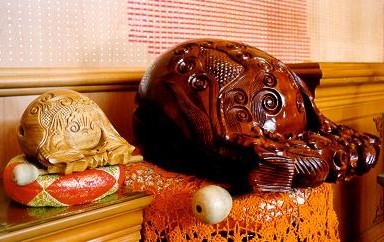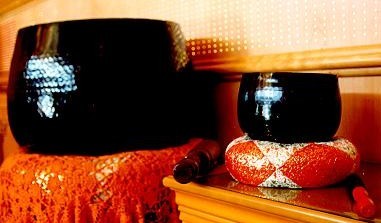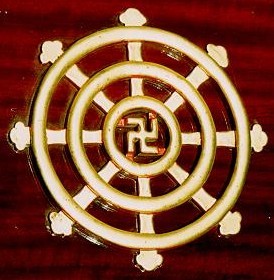Wooden Fish – the Lead of Chanting Sessions

The wooden fish is one of the most important Dharma instruments that leads and controls morning and evening chanting sessions in a Buddhist temple. When you enter the shrine of a temple, the fish shaped object that you see on the side of the altar is what we called the “wooden fish”. Some may ask the question: “Why is it made in the shape of a fish?”
It is said in “Pai Chang’s Monastic Regulations” that fish do not close their eyes and therefore are awake through out night and day. Hence Buddhists carve pieces of timber into the shape of a fish, and knock on it during chanting sessions. This is to remind the sentient beings not to doze off or slack off on their cultivation. At the very beginning, the wooden fish was in the shape of fish that have a long body. They are suspended outside the dining hall or on the corridor of the storehouse in Buddhist Temples. It is used to gather all members of the temple. Gradually, it developed into a round shape which is placed inside shrines of the temple. The reverend on duty will knock on the wooden fish at different beats in order to control the pace of the chanting session as well as to keep everybody clear minded. Patterns on the wooden fish may vary from pictures of two fish to just one single fish, some even contain a fish of two heads and one body. According to the legends, this pattern signifies the evolution of a fish into a dragon, that is, the transition from an ordinary human bring into a saint.
There is also a story about the wooden fish and the wooden fish stick…
Once upon a time, a woodchopper was cutting down trees in the woods. In order to defend himself from a snake, he attacked it with a stick. Thinking that the snake is dead, he left the place. However, the snake was still alive and when the woodchopper saw it again he beat the snake to death to make sure that it was dead.
A few days later, his neighbor’s dog had some puppies and the neighbor gave one of them to the woodchopper. This puppy was very obedient and adorable. One day, the woodchopper took this puppy to a Buddhist temple, an old Buddhist monk saw the puppy and said to the woodchopper:
“This puppy was born to take revenge on you. On the day of the Dragon Boat Festival, place a scarecrow on your bed and then hide in a safe spot. This way you will be able to save your own life.”
When this day came, the woodchopper did as the monk said. As expected, the puppy was not itself. It jumped onto the bed and started scratching and biting the scarecrow. The woodchopper became very angry and he killed the puppy.
After a few days, he saw a very beautiful woman when he was chopping trees in the woods. But, as he went near the woman, he would find that she has disappeared. This same incident occurred for a few days in a row and he started to feel frightened. The woodchopper sought for advice from the old monk and the old monk said to him:
“The snake that you killed had turned in to an evil spirit and it wants to kill you. Quick! I’ll invert the urn so you can hide inside. This way the snake won’t get to you and when it goes away I’ll come and let you out.” When the snake came, it realized that the woodchopper was hiding inside the urn so it wrapped itself around the urn with all its strength. The woodchopper ran out of air while the snake ran out strength and they both died. The old monk buried them in separate spots of the ground, but a tree and a vine grew out from these two spots. The taller the tree grew, the vine will extend itself to that length. The old monk saw this and sighed: “When will this vicious cycle of revenge end? Even a tree cannot get away from it.” He cut down the tree can made it into a wooden fish, and the vine into the wooden fish stick. Everyday, during chanting sessions, he would knock the wooden fish with the stick and recite: “Cause and effect, cause and effect…”
Bell Bowl (Da Qing) – The Dharma Stone: Shape of a Bowl and Sound of Gong

QIANG! QIANG! QIANG!
During chanting sessions or Dharma functions in a temple, these three consecutive sounds will enable all participants to regulate their thoughts and calm their minds. By doing this, people will be able to achieve better interactions with the Buddhas and Bodhisattvas through deeper sincerity.
Qing, is one of the Dharma implements used during chantings as well as Buddhist hymns. They may be made from stone or jade, but the majority are made from metals such as bronze or steel. Other than chanting sessions and Dharma functions, whenever an eminent monk or the Abbott of a temple is visiting another temple, as they enter the shrine to pay respect to the Buddha, the Da-Qing must be sounded three times as they make prostrations, following that, the Abbott of that temple will come to greet the guests.
The shapes of Da-Qing can be long, round, flat or small. The long ones can be seen in various thickness and length during festivals, and all of them create different sounds. The round shape is mostly seen in Buddhist temples. It has been mentioned that: ” The shape of Qing used by the Sangha is different from those of music which are in the shape boards…. The Qing used by the Sangha is in the shape of a bowl.” The flat Qing are those that are suspended outside the room of the temple’s Abbott. If there is someone to meet the Abbott, the reverend on duty will sound the Qing as to notify the Abbott that someone is here. The small Qing is the one that controls the pace of everyone making prostrations to the Buddha.
It is recorded in the Sutras that in Buddha’s time, Ananda (one of Buddha’s ten major disciples) discovered a Da-Qing which was made from Bronze and around it was patterns of clouds carved in gold, and in the middle were patterns of nine dragons. When this Da-Qing is sounded a voice that preaches Buddha’s teachings will permeate through the three thousand realms. However, after Buddha entered Nirvana this Da-Qing was taken back by king of the Dragon Palace.
One night, inside a Buddha hall, the Da-Qing complains to the Buddha’s Statue: “Why is it that, being made from the same material we are treated in such different ways. You are placed in such a high position and people always pay respect to you, but they always hit me. This is so unfair!”
Buddha replied with compassion: “There is no need for you to complain. Did you know that through out the process of my creation, I had to go through the pain of being hit and carved by hammers and knifes. Anything that seemed imperfect in me will cause more refinement on my body. Now, all you have to go through is a few knocks and you are already complaining, so all you can ever be is a Da-Qing.”
Isn’t this true! Anything thing you are doing, if you can overcome all obstacles and hardships as well as accept all the stress that comes with it, you are bound to be successful one day.
Dharma Wheel

The term “Dharma” refers to the Buddha’s teachings and the essential truths of Buddhism. A person may learn of the Dharma from sutras and teachers, but most importantly it must be practiced in daily life. The eight-spoked Dharma wheel symbolises Sakyamuni Buddha’s supreme enlightenment and his subsequent teachings which set what Buddhists call the Wheel of Law in motion.
Each spoke of the Dharma wheel corresponds to one element of the Noble Eightfold Path:
- Right Understanding: Comprehending the Law of Cause and Effect.
- Right Thought: A mind free from greed, anger and ignorance.
- Right Speech: Speech free from deceit, malice, and idle chatter.
- Right Action: No killing, stealing, or adultery.
- Right Livelihood: No occupation which causes harm.
- Right Diligence: Sincerely striving to do one’s best.
- Right Mindfulness: Maintaining constant awareness.
- Right Meditation: Calming the mind to help see the truth.
Like an ever-turning wheel, these teachings are timeless and will continue to benefit beings into the future.
